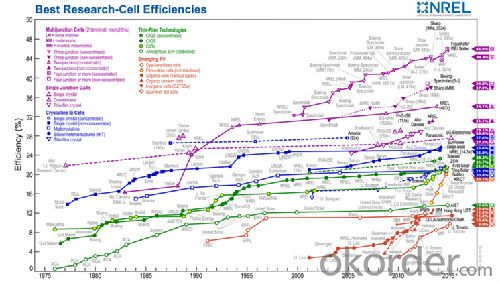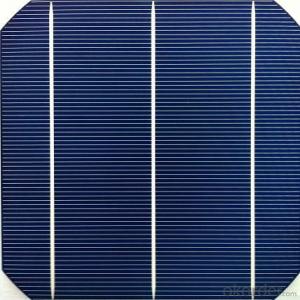Dye-Sensitised Monocrystalline 156 mm x 156 mm Solar Cells Supplier from China
- Loading Port:
- Shanghai
- Payment Terms:
- TT or LC
- Min Order Qty:
- 5000 pc
- Supply Capability:
- 80000 pc/month
OKorder Service Pledge
OKorder Financial Service
You Might Also Like
Brief Introduction of Solar Cells
A solar cell, is an electrical device that converts the energy of light directly into electricity by the photovoltaic effect, which is a physical and chemical phenomenon. It is a form of photoelectric cell, defined as a device whose electrical characteristics, such as current, voltage, or resistance, vary when exposed to light. Solar cells are the building blocks of photovoltaic modules, otherwise known as solar panels.
Advantage of Monocrystalline Solar Cells
• High efficiency and stable performance in photovoltaic conversion.
• Advanced diffusion technique ensuring the homogeneity of energy conversion efficiency of the cell.
• Advanced PECVD film forming, providing a dark blue silicon nitride anti-reflection film of homogenous color and attractive appearance.
• High quality metal paste for back surface and electrode, ensuring good conductivity, high pulling strength and ease of soldering.
• High precision patterning using screen printing, ensuring accurate busbar location for ease with automatic soldering a laser cutting.
Specifications of Monocrystalline Solar Cells
Format : 156 mm × 156 mm ± 0.5 mm
Thickness: 210 μm ±40 μm
Front (-) : 1.5mm bus bars (silver),blue anti-reflection coating (silicon nitride)
Back (+) : 2.5mm wide soldering pads (silver) back surface field (aluminium)
Efficiency (%) Pmpp (W) Umpp (V) Impp (A) Uoc (V) Isc (A) |
18.20% 4.43 0.536 8.263 0.634 8.712 |
18.00% 4.38 0.535 - 8.188 0.633 8.701 |
17.80% - 4.33 0.534 - -8.112 ---0.632 ----8.652 |
17.60% 4.28 0.533 8.036 0.631 8.641 |
17.40% 4.23 0.529 8.005 0.630 8.591 |
17.20% 4.19 0.525 7.973 0.627 8.542 |
17.00% 4.14 0.522 7.926 0.624 8.495 |
16.80% 4.09 0.518 7.893 0.620 8.452 |
16.60% 4.04 0.515 7.844 0.617 8.410 |
16.40% 3.99 0.514 7.765 0.616 8.373 |
16.20% 3.94 0.511 7.715 0.615 8.317 |
16.00% 3.89 0.509 7.650 0.613 8.251 |
Usage of Monocrystalline Solar Cells
Solar cells are often electrically connected and encapsulated as a module. Photovoltaic modules often have a sheet of glass on the front (sun up) side, allowing light to pass while protecting the semiconductor wafers from abrasion and impact due to wind-driven debris, rain, hail, etc. Solar cells are also usually connected in series in modules, creating an additive voltage. Connecting cells in parallel will yield a higher current; our solar cells have passed IEC Certification. With high and stable quality, our cells can greatly improve the performance of Solar Modules.
Packaging & Delivery of Monocrystalline Solar Cells
Carton Box Package and Deliver by air. It should be noticed that it should be avoid of water, sunshine and moist.



FAQ
We have organized several common questions for our clients,may help you sincerely:
①What price for each watt?
It depends on the efficiency of the solar cell, quantity, delivery date and payment terms.
②How long can we receive the product after purchase?
In the purchase of product within three working days, We will arrange the factory delivery as soon as possible. The pecific time of receiving is related to the state and position of customers.Commonly 7 to 10 working days can be served.
③Can you provide the peripheral products of the solar panels, such as the battery, controller, and inverter? If so, can you tell me how do they match each other?
Yes, we can, we have two companies for solar region, one is CNBM International, the other is CNBM engineering Co.
We can provide you not only the solar module but also the off grid solar system, we can also provide you service with on grid plant.
④What is your warranty of solar cell?
Our product can promise lower than 0.3% open box crack, we support claim after opening the box if it has crackm color difference or sth, the buyer should give pictures immediately, we can not accept the claim after the solar cell has assembled to solar panel.
• Timeliness of delivery
• ⑤How do you pack your products?
We have rich experience on how to pack the solar cell to make sure the safety on shipment, we could use wooden box or pallet as buyer's preference.
⑥ Can you do OEM for us?
Yes, we can.
Research direction of solar cell supplier
Now what solar cells suppliers are researching for? I think we all know the past few years, the photovoltaic industry in a slump, the reason that the industry cannot get rid of supporting policies is that the production costs are too high, so now all of them are desperately looking for a low-cost solar cell system, in the early stage of new materials or even tolerate its efficiency is very low. These low-cost battery can be attributed to the third generation of solar cells in the family, but also the story from 20 years ago talking about: the first line is the year Kodak has not closed down, a Chinese researcher found that organic dyes can also produce the photoelectric effect. Then European scholars dioxide nanoparticles staining, actually made an 8% efficiency solar cell chemistry, which is a dye-sensitized cells, 13% of the world record two years ago after the last time he climbed nature almost extinct from academia. The second line is a conductive organic Nobel Prize, we have to study photoelectric conversion, electric light switch or is organic led display, commercial very successful, who knows dynasty transfer power (that is, the solar cell) was actually a pit. But the Nobel laureate is still hopeful to open an organic photovoltaic company to give the Clinton administration's strong support; the result has been wiped out in order get the 2008 financial crisis. The battery has just broken the world record 10% of it. The third line is to make dye-sensitized cells found in the Japanese organic-inorganic hybrid material which can replace the perovskite structure of the dye, the efficiency of 3%. Europeans found that the material itself is a good photovoltaic semiconductor material, is now the world record by the Korean remained at 20%, last month issued a science. These three lines of batteries are the order of the temperature at room temperature with a chemical solution can be synthesized, lower cost than silicon cells, the question is not high enough efficiency lifetime is not long enough, but due to the relatively low barriers to entry (chemical laboratory on the line) Therefore worldwide research group particularly impact factor in the field have gone.
Now what solar cells suppliers are researching? Simply put, that is efficient and cost. Close to the production of research and development, the first is the original laboratory can efficiently process into mass production process, such as PERC, HIT, IBC, etc; more front-end development, is looking for more efficient and lower cost of battery cells materials, such as laminated battery, battery perovsk

- Q: Can solar cells be used to power water purification systems?
- Yes, solar cells can be used to power water purification systems. Solar cells convert sunlight into electricity, which can then be used to power various devices, including water purification systems. This allows for a sustainable and environmentally-friendly solution to provide clean and safe drinking water in areas without access to electricity grids.
- Q: Can solar cells be used for powering transportation infrastructure?
- Yes, solar cells can be used for powering transportation infrastructure. Solar-powered electric vehicles, such as solar cars, solar buses, and solar trains, are already being developed and deployed in various parts of the world. Additionally, solar energy can also be used to provide power for charging stations and electric vehicle infrastructure, reducing reliance on traditional energy sources and promoting sustainability in transportation.
- Q: Can solar cells be used on backpacks or camping gear?
- Yes, solar cells can be used on backpacks or camping gear. These portable solar panels can be attached to backpacks, tents, or other camping gear to harness solar energy and charge devices such as smartphones, GPS devices, or portable speakers while on the go. This allows campers and hikers to have a reliable source of power in remote locations and reduces the need for carrying extra batteries or relying on traditional power sources.
- Q: What happens to excess electricity generated by solar cells?
- Excess electricity generated by solar cells can be stored in batteries for later use or can be fed back into the grid, allowing others to benefit from the surplus energy.
- Q: Can solar cells be integrated into electric vehicle charging stations?
- Yes, solar cells can definitely be integrated into electric vehicle charging stations. By harnessing solar energy, these charging stations can provide an environmentally-friendly and sustainable source of power for electric vehicles, reducing their carbon footprint and reliance on fossil fuels.
- Q: The working principle of solar cells includes the three processes
- The opposite of the electrical symbol of the photogenerated carriers in the solar cell pn junction built under the action of the electric field, the electron-hole pairs are separated, the electrons are concentrated on one side, the holes are concentrated on the other side, and the opposite sex charges are generated on both sides of the pn junction Of the accumulation, resulting in photogenerated electromotive force, that is, photovoltaic voltage.
- Q: What is the role of solar cells in powering electric vehicles?
- Solar cells play a crucial role in powering electric vehicles by converting sunlight into electricity. They are typically installed on the surface of the vehicle, such as the roof or hood, and capture solar energy to charge the vehicle's battery. While solar cells alone may not provide sufficient power to fully drive an electric vehicle, they can help extend its range and reduce dependence on the electrical grid.
- Q: Is the Photovoltaic Cells cheap to buy?
- Compared to the other product which can generate the power, the Photovoltaic Cells are not cheap at all. However, if you take a look at all the solar cells product in the market, Photovoltaic Cells are actually comsidered to be cheap.
- Q: Can solar cells be used for powering desalination plants?
- Yes, solar cells can be used for powering desalination plants. Solar energy can be harnessed through photovoltaic panels, which convert sunlight into electricity. This electricity can then be used to power the desalination process, where saltwater is converted into freshwater through various methods such as reverse osmosis or distillation. Utilizing solar cells for powering desalination plants offers a sustainable and renewable energy source, reducing reliance on fossil fuels and minimizing the environmental impact of the desalination process.
- Q: Can solar cells be used in powering RVs and campers?
- Yes, solar cells can definitely be used to power RVs and campers. In fact, many RVs and campers are now equipped with solar panels to generate electricity for various appliances and systems onboard. Solar power provides a sustainable and environmentally-friendly option for off-grid living, allowing RV and camper owners to have a constant source of clean energy while being able to travel and explore remote locations without relying solely on traditional power sources.
Send your message to us
Dye-Sensitised Monocrystalline 156 mm x 156 mm Solar Cells Supplier from China
- Loading Port:
- Shanghai
- Payment Terms:
- TT or LC
- Min Order Qty:
- 5000 pc
- Supply Capability:
- 80000 pc/month
OKorder Service Pledge
OKorder Financial Service
Similar products
Hot products
Hot Searches
Related keywords



























